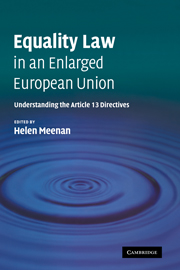Book contents
- Frontmatter
- Contents
- Preface
- Acknowledgements
- List of contributors
- Abbreviations
- Table of Cases
- PART I
- PART II
- 5 EU sex equality law post-Amsterdam
- 6 EU anti-racism policy; the leader of the pack?
- 7 Religion or belief; aiming at the right target?
- 8 Disability discrimination law in the European Union
- 9 Age discrimination – Of Cinderella and The Golden Bough
- 10 The ‘mainstreaming’ of sexual orientation into European equality law
- 11 Conclusion
- Index
10 - The ‘mainstreaming’ of sexual orientation into European equality law
Published online by Cambridge University Press: 22 August 2009
- Frontmatter
- Contents
- Preface
- Acknowledgements
- List of contributors
- Abbreviations
- Table of Cases
- PART I
- PART II
- 5 EU sex equality law post-Amsterdam
- 6 EU anti-racism policy; the leader of the pack?
- 7 Religion or belief; aiming at the right target?
- 8 Disability discrimination law in the European Union
- 9 Age discrimination – Of Cinderella and The Golden Bough
- 10 The ‘mainstreaming’ of sexual orientation into European equality law
- 11 Conclusion
- Index
Summary
Introduction
This chapter will examine the development of European equality law in the context of the emergence of sexual orientation as an equality law ground. Its focus will be an examination of the provisions of the Framework Directive as they particularly apply to sexual orientation discrimination and the rights of lesbians, gays and bisexuals (LGBs). It is considered necessary, when approaching new equality grounds, to take an integrated but differentiated approach integrated in the sense that many of the legal definitions (and practical implications) of new grounds are common to those of pre-existing grounds, but also differentiated in that each new ground presents issues and controversies which are particular to that ground. The latter perspective is not to endorse a hierarchy of inequality but rather to acknowledge the differences between them.
In this sense, at the level of European equality law, sex equality has been the ‘mainstream’ focus of attention for over 30 years. The main challenge of the Race and Framework Directives is partly to integrate the new equality grounds into established practices on recruitment, harassment, etc. But the second challenge is to appreciate that women, racial and religious minorities, the disabled, younger and older people and LGBs all face differing issues and that what has been a sensible approach to established grounds may need rethought and modification to deal with new grounds.
- Type
- Chapter
- Information
- Equality Law in an Enlarged European UnionUnderstanding the Article 13 Directives, pp. 313 - 341Publisher: Cambridge University PressPrint publication year: 2007
- 1
- Cited by



